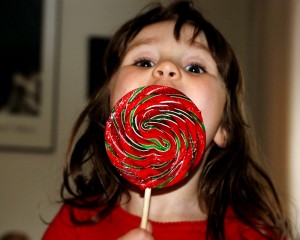“Science and everyday life cannot and should not be separated.”
– Rosalind Franklin

Photo by Kyle Flood via Wikipedia
While Franklin was talking in a much broader way about the use of science to further human wellbeing, science can also be applied to the smaller problems of everyday life. Sometimes even to problems that no one even suggested need a scientific explanation at all. Effects like the spilling of coffee[1] or the crumpling of sheets [2]. Things that everybody can relate to.
To sustain the mental effort of solving such puzzling problems the scientists need energy. If the scientists in question have a sweet tooth this energy can conveniently be provided by the sugar contained in candies and so it was only a matter of time until the next everyday effect found its way into a scientific journal: The process of eating candy.
In a recent paper by Windisch et al. [3] the question of how candies dissolve is addressed for the first time. A simple model for the dissolution of a spherical candy is proposed. This model represents the condition of moving the candy gently in your mouth without applying too much pressure. In this case the spherical shape of the candy is preserved and the lifetime of the candy is extended. You can enjoy your candy longer.
This happens because a sphere has the best volume to surface ratio and the surface area is what limits the dissolution under these conditions. The larger the surface area, the faster the candy will dissolve. Accordingly if you break the candy with your teeth the bits will dissolve much faster. It is of course a matter of personal taste if one prefers to have the sugar rush from dissolving the candy in a short period of time or the slow sweetness from a gradually vanishing candy.
The study did not include any specific chemical effects and one can surely think of more than the two ways presented to eat candies. Additionally candies come in many forms besides homogeneous spheres. So there are many more variables to consider until the optimal candy eating strategy for each person is found. But to quote the authors [3]: “[…] the best thing to do when eating a candy is to forget about these considerations, since they draw your attention away from what candies are made for—enjoyment. ”
Stephan Koehler
[1] Mayer, H., Krechetnikov, R., “Walking with coffee: Why does it spill?”. PRE 85, 046117 (2012)
[2] Cerda, E., Mahadevan, L., “Conical Surfaces and Crescent Singularities in Crumpled Sheets”. PRL 80, 2358 (1998)
[3] Windisch A., Windisch H., Windisch A., “Sticky physics of joy: on the dissolution of spherical candies ”. Phys. Educ. (48), 221 (2013)